BUSM4590 People and Organizations Report: HR Practices Analysis
VerifiedAdded on 2022/11/19
|13
|3137
|423
Report
AI Summary
This report provides a comprehensive analysis of human resource (HR) practices, conflict management strategies, ethical considerations in the workplace, and effective questioning techniques. The report begins by defining the role of HR in an organization and its importance in managing employee relations, recruitment, and ethical behavior. It then delves into conflict management, outlining various approaches such as avoiding, giving in, standing your ground, collaborating, compromising, and competing, with emphasis on establishing ground rules and open communication. The report also explores ethical HR practices, emphasizing the importance of hiring practices, leading by example, continuing education, an open-door policy, and prioritizing professional development. Finally, it examines questioning strategies for interviews, including open, closed, funnel, probing, and leading questions, to gather information and build relationships. The report uses relevant theories and workplace examples to provide practical recommendations for managing people in organizations. This report is a contribution to Desklib, a platform offering AI-based study tools for students.
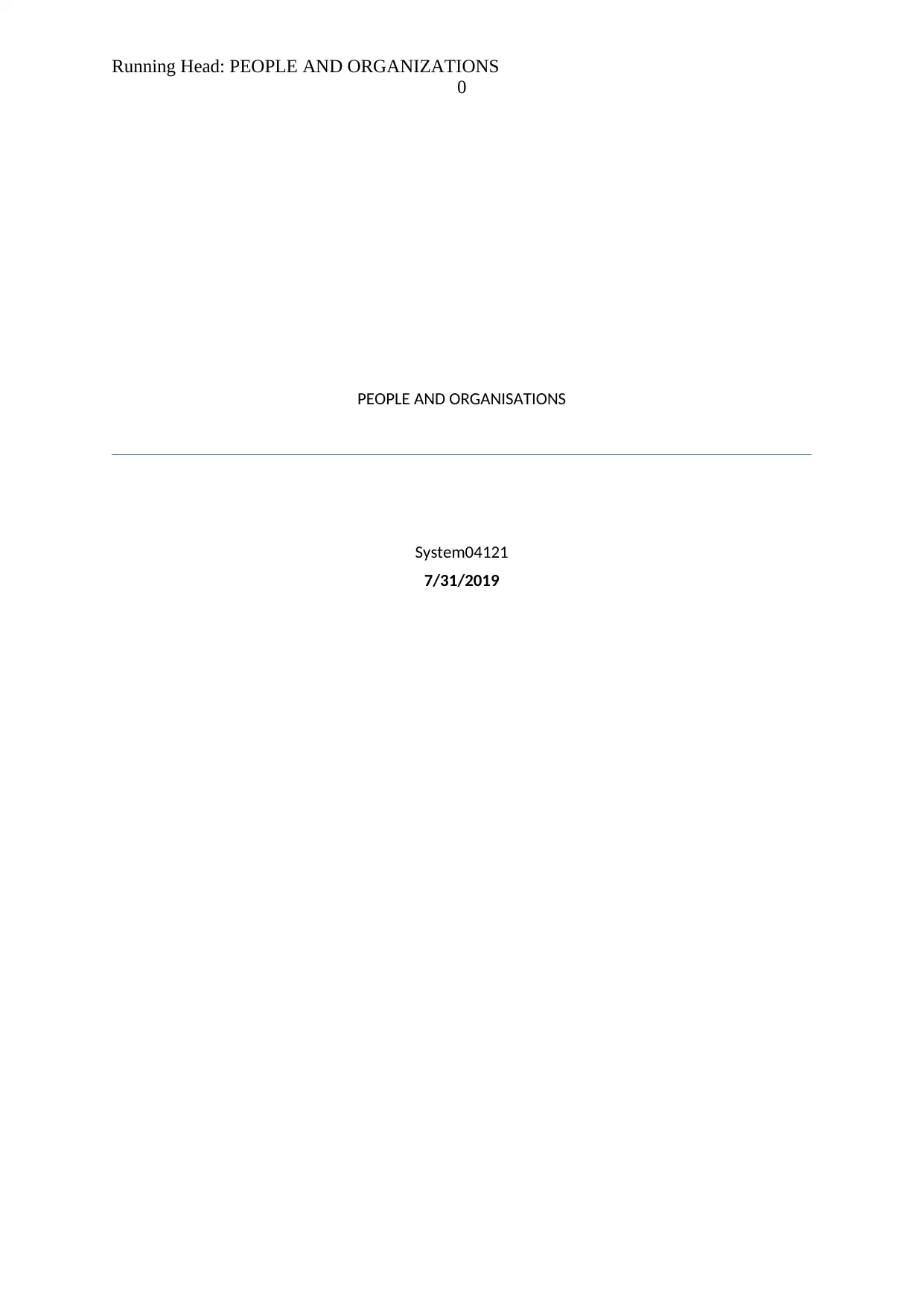
Running Head: PEOPLE AND ORGANIZATIONS
0
PEOPLE AND ORGANISATIONS
System04121
7/31/2019
0
PEOPLE AND ORGANISATIONS
System04121
7/31/2019
Paraphrase This Document
Need a fresh take? Get an instant paraphrase of this document with our AI Paraphraser
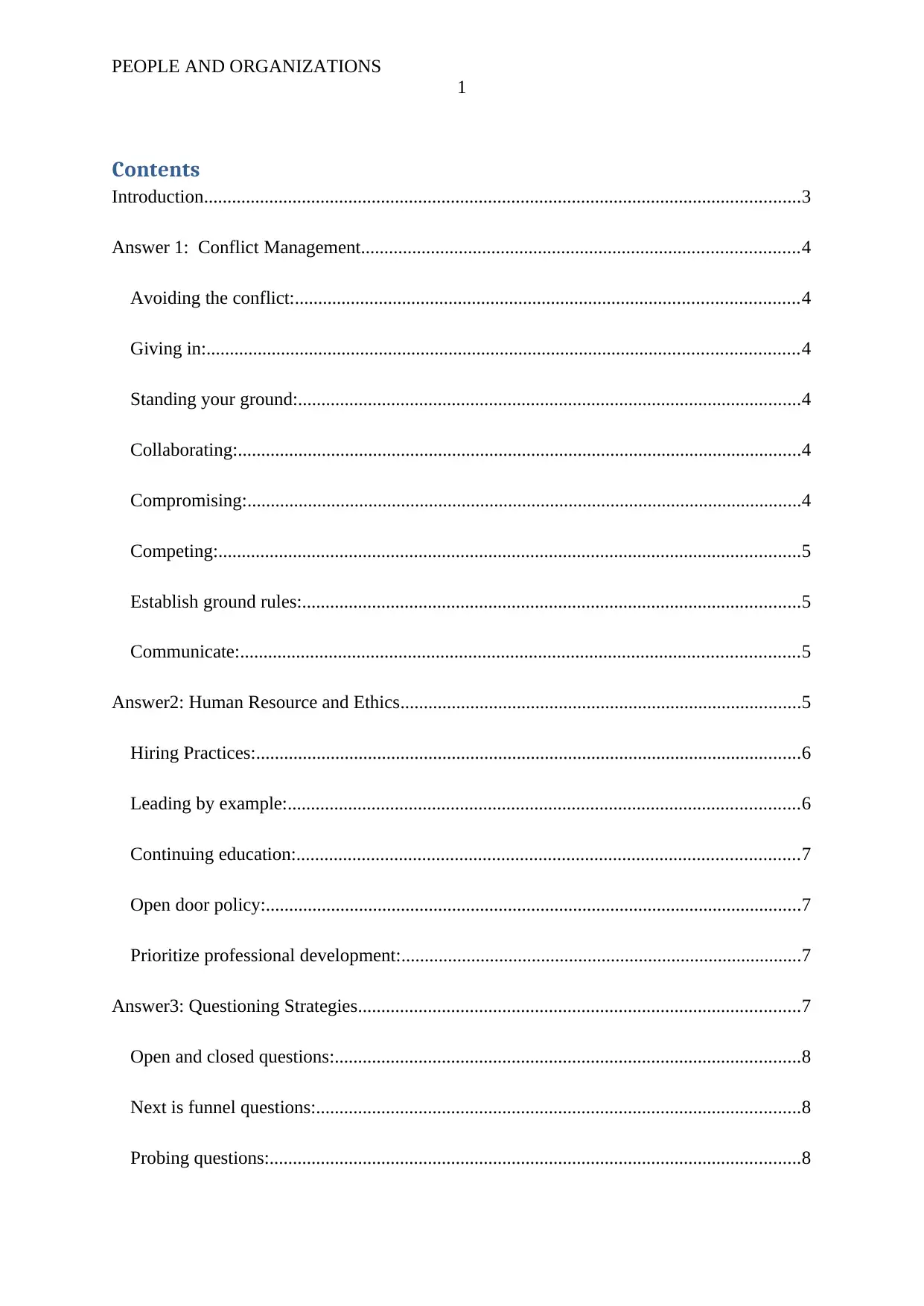
PEOPLE AND ORGANIZATIONS
1
Contents
Introduction................................................................................................................................3
Answer 1: Conflict Management..............................................................................................4
Avoiding the conflict:............................................................................................................4
Giving in:...............................................................................................................................4
Standing your ground:............................................................................................................4
Collaborating:.........................................................................................................................4
Compromising:.......................................................................................................................4
Competing:.............................................................................................................................5
Establish ground rules:...........................................................................................................5
Communicate:........................................................................................................................5
Answer2: Human Resource and Ethics......................................................................................5
Hiring Practices:.....................................................................................................................6
Leading by example:..............................................................................................................6
Continuing education:............................................................................................................7
Open door policy:...................................................................................................................7
Prioritize professional development:......................................................................................7
Answer3: Questioning Strategies...............................................................................................7
Open and closed questions:....................................................................................................8
Next is funnel questions:........................................................................................................8
Probing questions:..................................................................................................................8
1
Contents
Introduction................................................................................................................................3
Answer 1: Conflict Management..............................................................................................4
Avoiding the conflict:............................................................................................................4
Giving in:...............................................................................................................................4
Standing your ground:............................................................................................................4
Collaborating:.........................................................................................................................4
Compromising:.......................................................................................................................4
Competing:.............................................................................................................................5
Establish ground rules:...........................................................................................................5
Communicate:........................................................................................................................5
Answer2: Human Resource and Ethics......................................................................................5
Hiring Practices:.....................................................................................................................6
Leading by example:..............................................................................................................6
Continuing education:............................................................................................................7
Open door policy:...................................................................................................................7
Prioritize professional development:......................................................................................7
Answer3: Questioning Strategies...............................................................................................7
Open and closed questions:....................................................................................................8
Next is funnel questions:........................................................................................................8
Probing questions:..................................................................................................................8
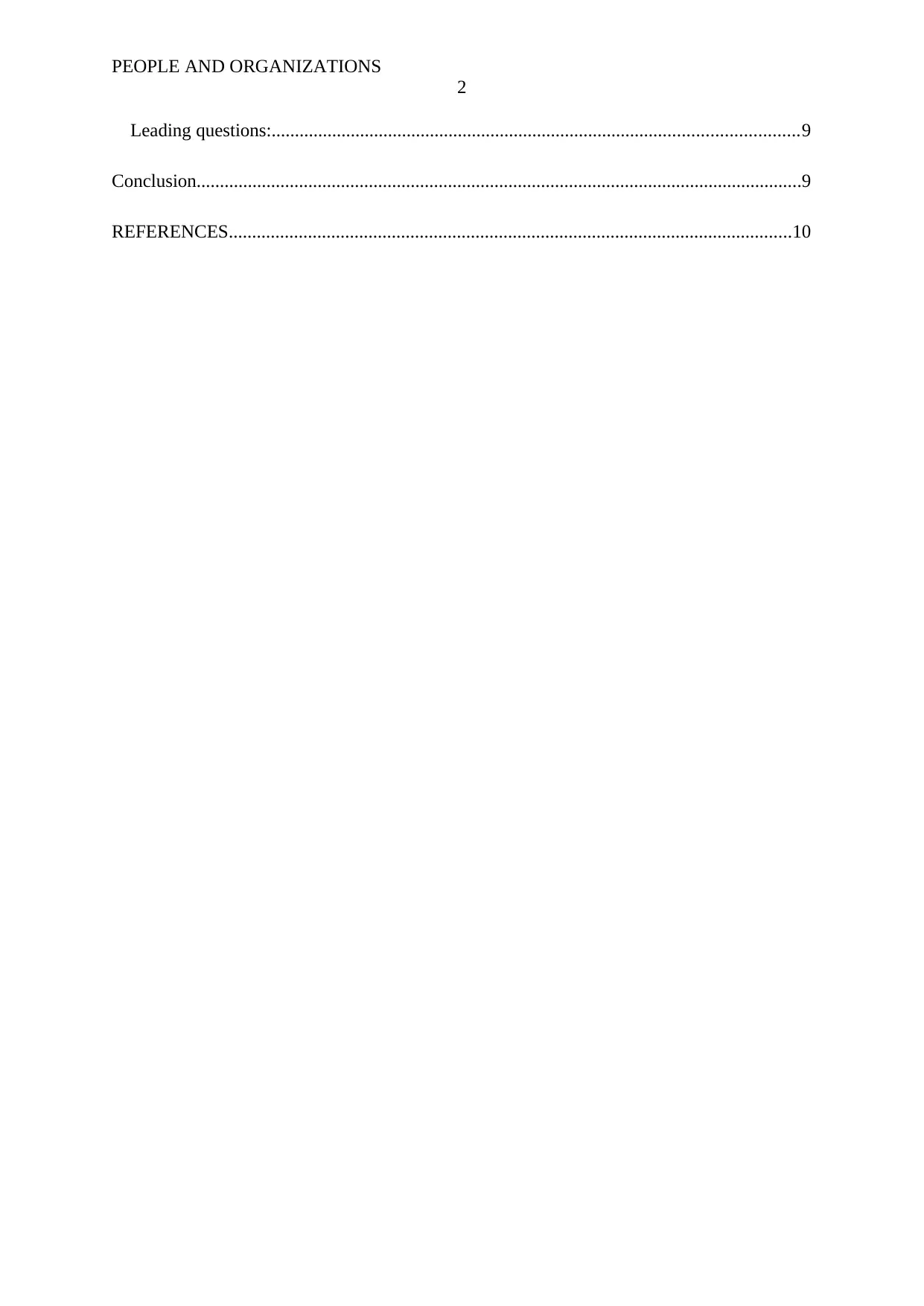
PEOPLE AND ORGANIZATIONS
2
Leading questions:.................................................................................................................9
Conclusion..................................................................................................................................9
REFERENCES.........................................................................................................................10
2
Leading questions:.................................................................................................................9
Conclusion..................................................................................................................................9
REFERENCES.........................................................................................................................10
⊘ This is a preview!⊘
Do you want full access?
Subscribe today to unlock all pages.

Trusted by 1+ million students worldwide
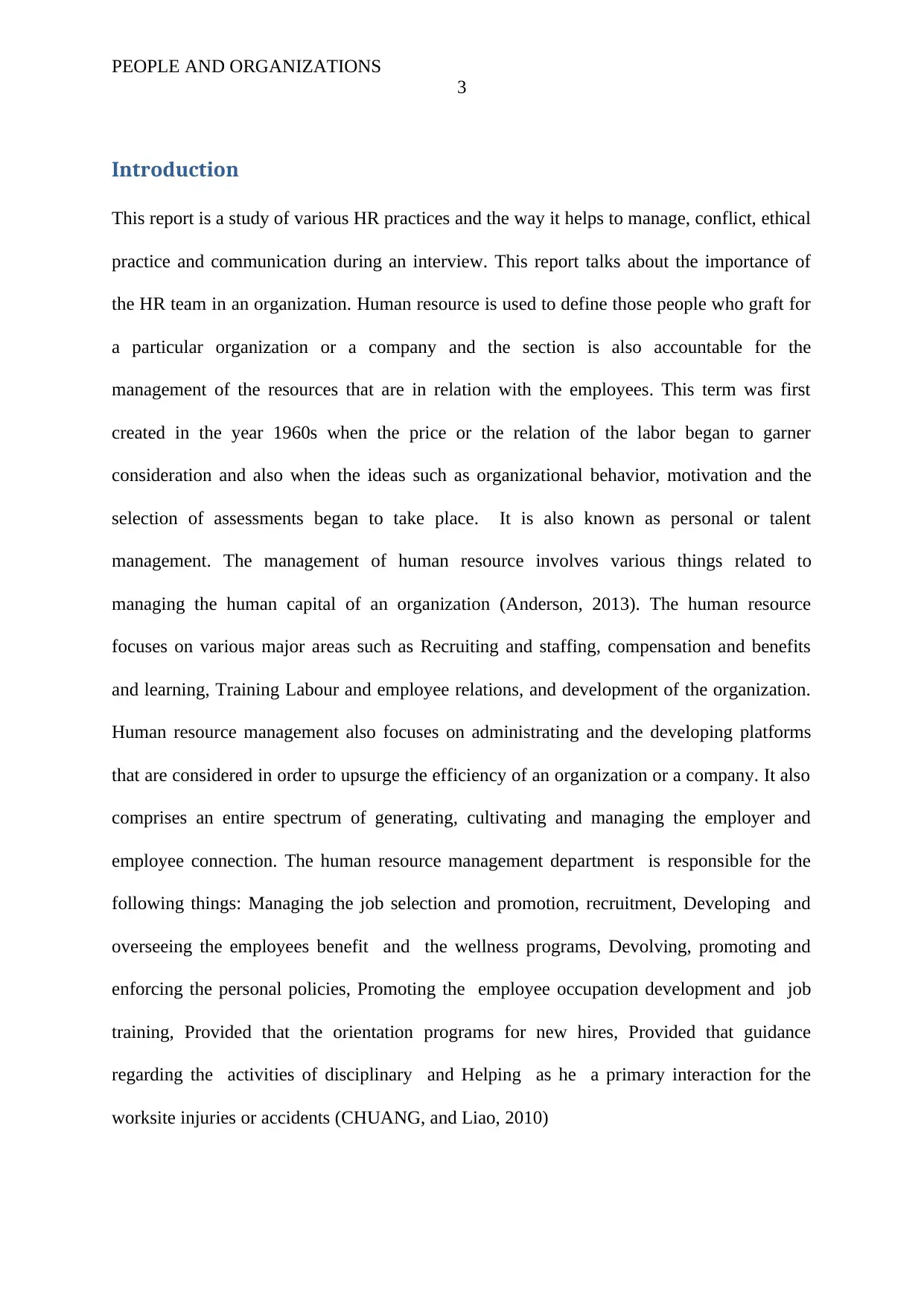
PEOPLE AND ORGANIZATIONS
3
Introduction
This report is a study of various HR practices and the way it helps to manage, conflict, ethical
practice and communication during an interview. This report talks about the importance of
the HR team in an organization. Human resource is used to define those people who graft for
a particular organization or a company and the section is also accountable for the
management of the resources that are in relation with the employees. This term was first
created in the year 1960s when the price or the relation of the labor began to garner
consideration and also when the ideas such as organizational behavior, motivation and the
selection of assessments began to take place. It is also known as personal or talent
management. The management of human resource involves various things related to
managing the human capital of an organization (Anderson, 2013). The human resource
focuses on various major areas such as Recruiting and staffing, compensation and benefits
and learning, Training Labour and employee relations, and development of the organization.
Human resource management also focuses on administrating and the developing platforms
that are considered in order to upsurge the efficiency of an organization or a company. It also
comprises an entire spectrum of generating, cultivating and managing the employer and
employee connection. The human resource management department is responsible for the
following things: Managing the job selection and promotion, recruitment, Developing and
overseeing the employees benefit and the wellness programs, Devolving, promoting and
enforcing the personal policies, Promoting the employee occupation development and job
training, Provided that the orientation programs for new hires, Provided that guidance
regarding the activities of disciplinary and Helping as he a primary interaction for the
worksite injuries or accidents (CHUANG, and Liao, 2010)
3
Introduction
This report is a study of various HR practices and the way it helps to manage, conflict, ethical
practice and communication during an interview. This report talks about the importance of
the HR team in an organization. Human resource is used to define those people who graft for
a particular organization or a company and the section is also accountable for the
management of the resources that are in relation with the employees. This term was first
created in the year 1960s when the price or the relation of the labor began to garner
consideration and also when the ideas such as organizational behavior, motivation and the
selection of assessments began to take place. It is also known as personal or talent
management. The management of human resource involves various things related to
managing the human capital of an organization (Anderson, 2013). The human resource
focuses on various major areas such as Recruiting and staffing, compensation and benefits
and learning, Training Labour and employee relations, and development of the organization.
Human resource management also focuses on administrating and the developing platforms
that are considered in order to upsurge the efficiency of an organization or a company. It also
comprises an entire spectrum of generating, cultivating and managing the employer and
employee connection. The human resource management department is responsible for the
following things: Managing the job selection and promotion, recruitment, Developing and
overseeing the employees benefit and the wellness programs, Devolving, promoting and
enforcing the personal policies, Promoting the employee occupation development and job
training, Provided that the orientation programs for new hires, Provided that guidance
regarding the activities of disciplinary and Helping as he a primary interaction for the
worksite injuries or accidents (CHUANG, and Liao, 2010)
Paraphrase This Document
Need a fresh take? Get an instant paraphrase of this document with our AI Paraphraser
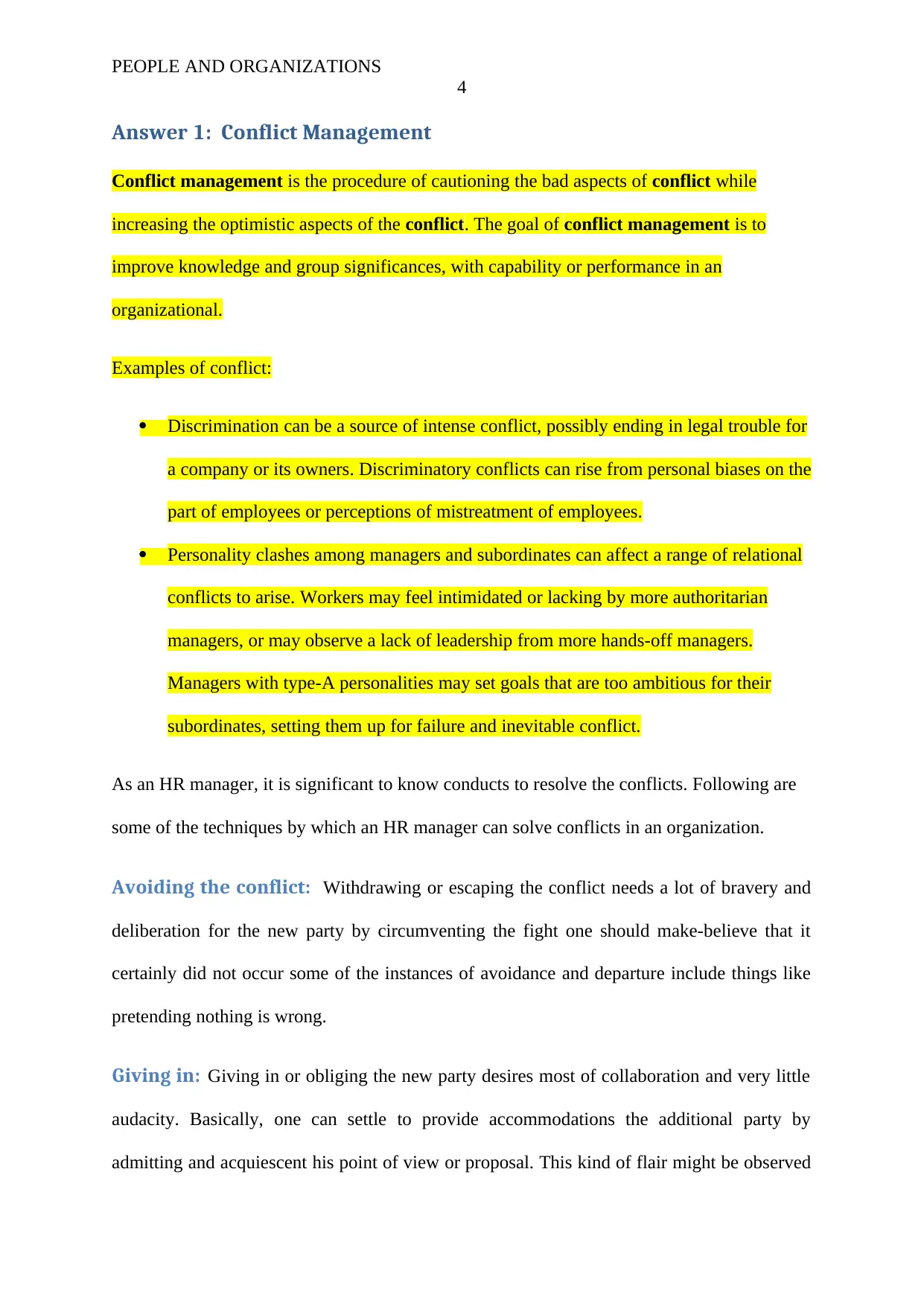
PEOPLE AND ORGANIZATIONS
4
Answer 1: Conflict Management
Conflict management is the procedure of cautioning the bad aspects of conflict while
increasing the optimistic aspects of the conflict. The goal of conflict management is to
improve knowledge and group significances, with capability or performance in an
organizational.
Examples of conflict:
Discrimination can be a source of intense conflict, possibly ending in legal trouble for
a company or its owners. Discriminatory conflicts can rise from personal biases on the
part of employees or perceptions of mistreatment of employees.
Personality clashes among managers and subordinates can affect a range of relational
conflicts to arise. Workers may feel intimidated or lacking by more authoritarian
managers, or may observe a lack of leadership from more hands-off managers.
Managers with type-A personalities may set goals that are too ambitious for their
subordinates, setting them up for failure and inevitable conflict.
As an HR manager, it is significant to know conducts to resolve the conflicts. Following are
some of the techniques by which an HR manager can solve conflicts in an organization.
Avoiding the conflict: Withdrawing or escaping the conflict needs a lot of bravery and
deliberation for the new party by circumventing the fight one should make-believe that it
certainly did not occur some of the instances of avoidance and departure include things like
pretending nothing is wrong.
Giving in: Giving in or obliging the new party desires most of collaboration and very little
audacity. Basically, one can settle to provide accommodations the additional party by
admitting and acquiescent his point of view or proposal. This kind of flair might be observed
4
Answer 1: Conflict Management
Conflict management is the procedure of cautioning the bad aspects of conflict while
increasing the optimistic aspects of the conflict. The goal of conflict management is to
improve knowledge and group significances, with capability or performance in an
organizational.
Examples of conflict:
Discrimination can be a source of intense conflict, possibly ending in legal trouble for
a company or its owners. Discriminatory conflicts can rise from personal biases on the
part of employees or perceptions of mistreatment of employees.
Personality clashes among managers and subordinates can affect a range of relational
conflicts to arise. Workers may feel intimidated or lacking by more authoritarian
managers, or may observe a lack of leadership from more hands-off managers.
Managers with type-A personalities may set goals that are too ambitious for their
subordinates, setting them up for failure and inevitable conflict.
As an HR manager, it is significant to know conducts to resolve the conflicts. Following are
some of the techniques by which an HR manager can solve conflicts in an organization.
Avoiding the conflict: Withdrawing or escaping the conflict needs a lot of bravery and
deliberation for the new party by circumventing the fight one should make-believe that it
certainly did not occur some of the instances of avoidance and departure include things like
pretending nothing is wrong.
Giving in: Giving in or obliging the new party desires most of collaboration and very little
audacity. Basically, one can settle to provide accommodations the additional party by
admitting and acquiescent his point of view or proposal. This kind of flair might be observed
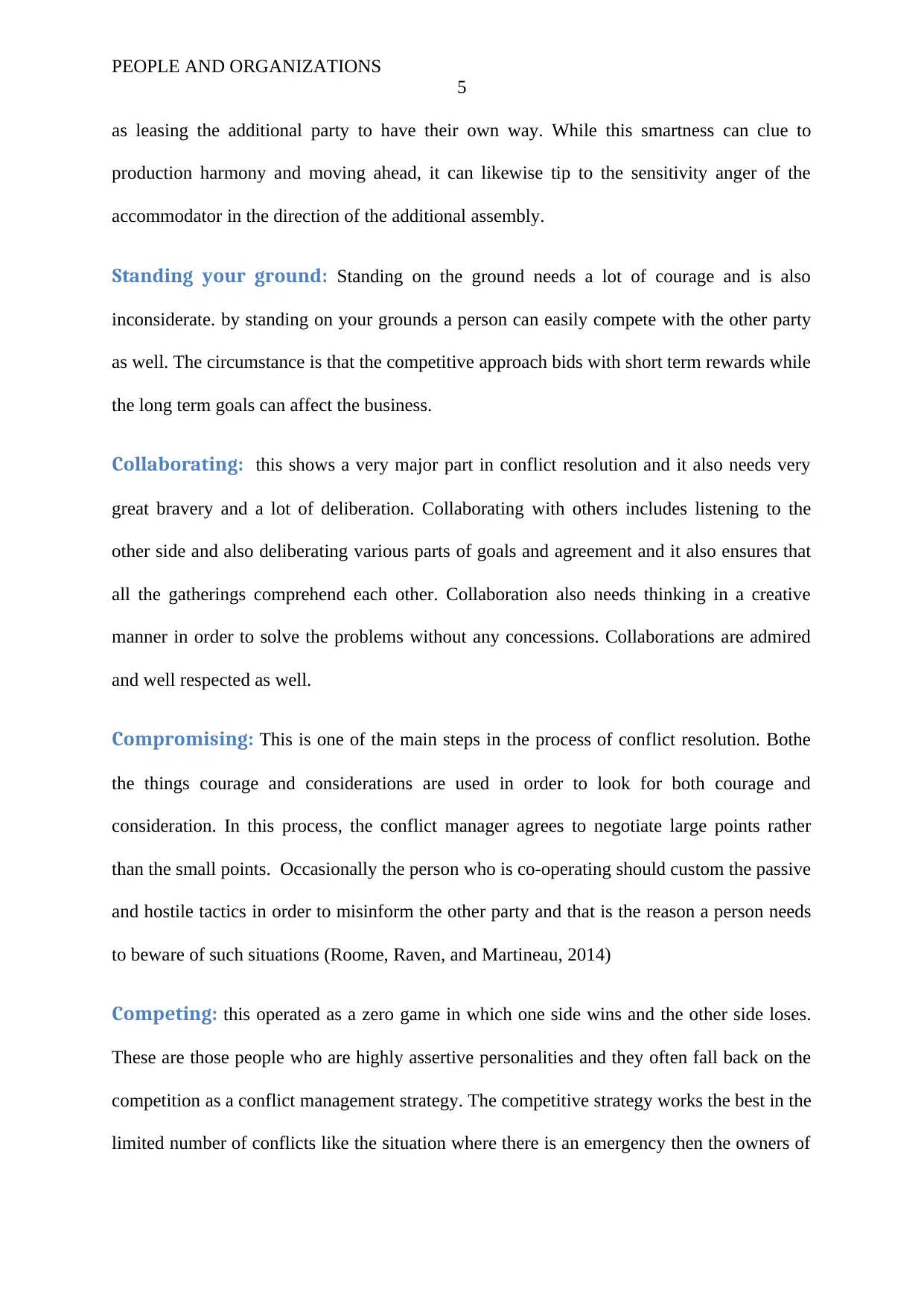
PEOPLE AND ORGANIZATIONS
5
as leasing the additional party to have their own way. While this smartness can clue to
production harmony and moving ahead, it can likewise tip to the sensitivity anger of the
accommodator in the direction of the additional assembly.
Standing your ground: Standing on the ground needs a lot of courage and is also
inconsiderate. by standing on your grounds a person can easily compete with the other party
as well. The circumstance is that the competitive approach bids with short term rewards while
the long term goals can affect the business.
Collaborating: this shows a very major part in conflict resolution and it also needs very
great bravery and a lot of deliberation. Collaborating with others includes listening to the
other side and also deliberating various parts of goals and agreement and it also ensures that
all the gatherings comprehend each other. Collaboration also needs thinking in a creative
manner in order to solve the problems without any concessions. Collaborations are admired
and well respected as well.
Compromising: This is one of the main steps in the process of conflict resolution. Bothe
the things courage and considerations are used in order to look for both courage and
consideration. In this process, the conflict manager agrees to negotiate large points rather
than the small points. Occasionally the person who is co-operating should custom the passive
and hostile tactics in order to misinform the other party and that is the reason a person needs
to beware of such situations (Roome, Raven, and Martineau, 2014)
Competing: this operated as a zero game in which one side wins and the other side loses.
These are those people who are highly assertive personalities and they often fall back on the
competition as a conflict management strategy. The competitive strategy works the best in the
limited number of conflicts like the situation where there is an emergency then the owners of
5
as leasing the additional party to have their own way. While this smartness can clue to
production harmony and moving ahead, it can likewise tip to the sensitivity anger of the
accommodator in the direction of the additional assembly.
Standing your ground: Standing on the ground needs a lot of courage and is also
inconsiderate. by standing on your grounds a person can easily compete with the other party
as well. The circumstance is that the competitive approach bids with short term rewards while
the long term goals can affect the business.
Collaborating: this shows a very major part in conflict resolution and it also needs very
great bravery and a lot of deliberation. Collaborating with others includes listening to the
other side and also deliberating various parts of goals and agreement and it also ensures that
all the gatherings comprehend each other. Collaboration also needs thinking in a creative
manner in order to solve the problems without any concessions. Collaborations are admired
and well respected as well.
Compromising: This is one of the main steps in the process of conflict resolution. Bothe
the things courage and considerations are used in order to look for both courage and
consideration. In this process, the conflict manager agrees to negotiate large points rather
than the small points. Occasionally the person who is co-operating should custom the passive
and hostile tactics in order to misinform the other party and that is the reason a person needs
to beware of such situations (Roome, Raven, and Martineau, 2014)
Competing: this operated as a zero game in which one side wins and the other side loses.
These are those people who are highly assertive personalities and they often fall back on the
competition as a conflict management strategy. The competitive strategy works the best in the
limited number of conflicts like the situation where there is an emergency then the owners of
⊘ This is a preview!⊘
Do you want full access?
Subscribe today to unlock all pages.

Trusted by 1+ million students worldwide
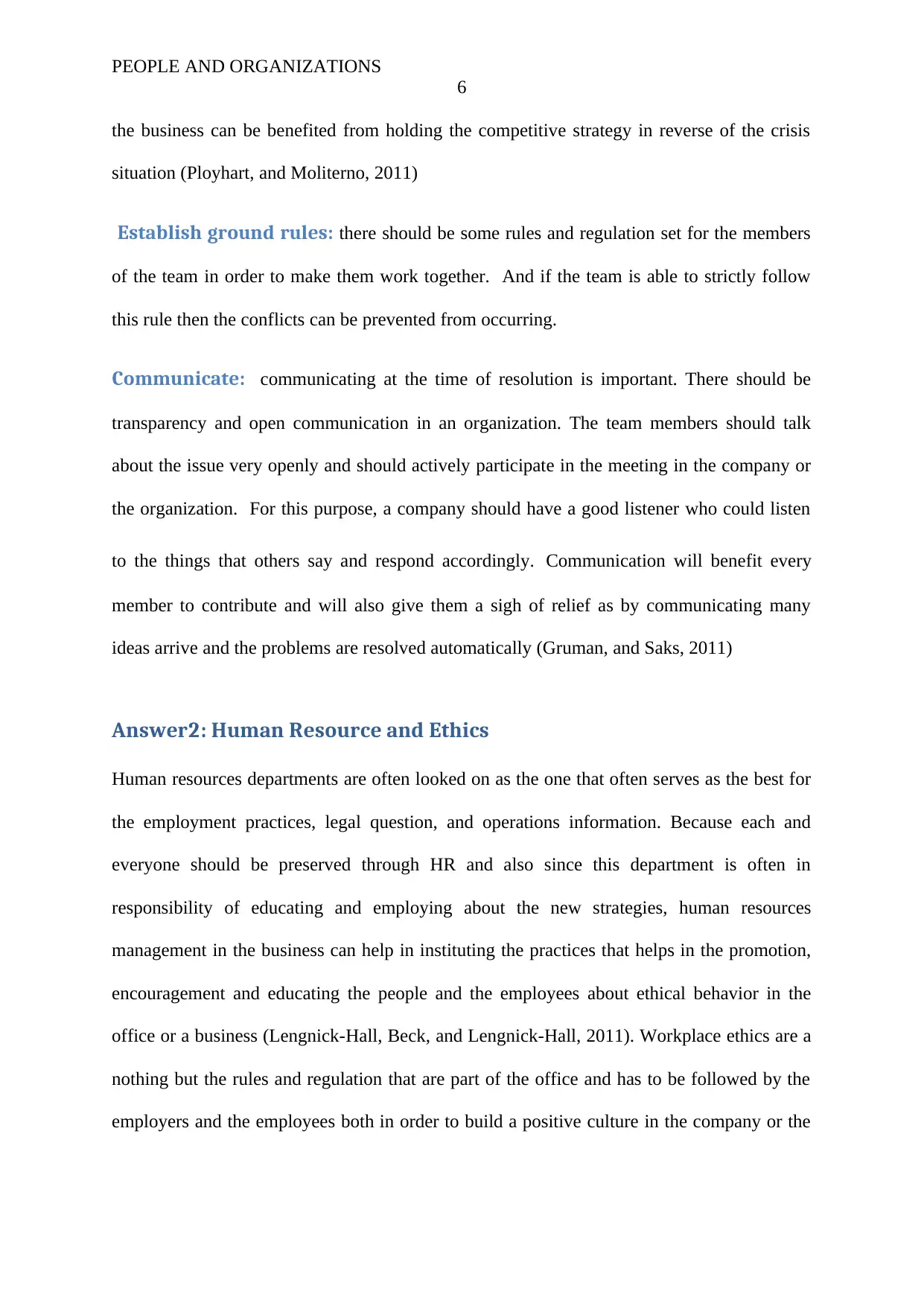
PEOPLE AND ORGANIZATIONS
6
the business can be benefited from holding the competitive strategy in reverse of the crisis
situation (Ployhart, and Moliterno, 2011)
Establish ground rules: there should be some rules and regulation set for the members
of the team in order to make them work together. And if the team is able to strictly follow
this rule then the conflicts can be prevented from occurring.
Communicate: communicating at the time of resolution is important. There should be
transparency and open communication in an organization. The team members should talk
about the issue very openly and should actively participate in the meeting in the company or
the organization. For this purpose, a company should have a good listener who could listen
to the things that others say and respond accordingly. Communication will benefit every
member to contribute and will also give them a sigh of relief as by communicating many
ideas arrive and the problems are resolved automatically (Gruman, and Saks, 2011)
Answer2: Human Resource and Ethics
Human resources departments are often looked on as the one that often serves as the best for
the employment practices, legal question, and operations information. Because each and
everyone should be preserved through HR and also since this department is often in
responsibility of educating and employing about the new strategies, human resources
management in the business can help in instituting the practices that helps in the promotion,
encouragement and educating the people and the employees about ethical behavior in the
office or a business (Lengnick-Hall, Beck, and Lengnick-Hall, 2011). Workplace ethics are a
nothing but the rules and regulation that are part of the office and has to be followed by the
employers and the employees both in order to build a positive culture in the company or the
6
the business can be benefited from holding the competitive strategy in reverse of the crisis
situation (Ployhart, and Moliterno, 2011)
Establish ground rules: there should be some rules and regulation set for the members
of the team in order to make them work together. And if the team is able to strictly follow
this rule then the conflicts can be prevented from occurring.
Communicate: communicating at the time of resolution is important. There should be
transparency and open communication in an organization. The team members should talk
about the issue very openly and should actively participate in the meeting in the company or
the organization. For this purpose, a company should have a good listener who could listen
to the things that others say and respond accordingly. Communication will benefit every
member to contribute and will also give them a sigh of relief as by communicating many
ideas arrive and the problems are resolved automatically (Gruman, and Saks, 2011)
Answer2: Human Resource and Ethics
Human resources departments are often looked on as the one that often serves as the best for
the employment practices, legal question, and operations information. Because each and
everyone should be preserved through HR and also since this department is often in
responsibility of educating and employing about the new strategies, human resources
management in the business can help in instituting the practices that helps in the promotion,
encouragement and educating the people and the employees about ethical behavior in the
office or a business (Lengnick-Hall, Beck, and Lengnick-Hall, 2011). Workplace ethics are a
nothing but the rules and regulation that are part of the office and has to be followed by the
employers and the employees both in order to build a positive culture in the company or the
Paraphrase This Document
Need a fresh take? Get an instant paraphrase of this document with our AI Paraphraser
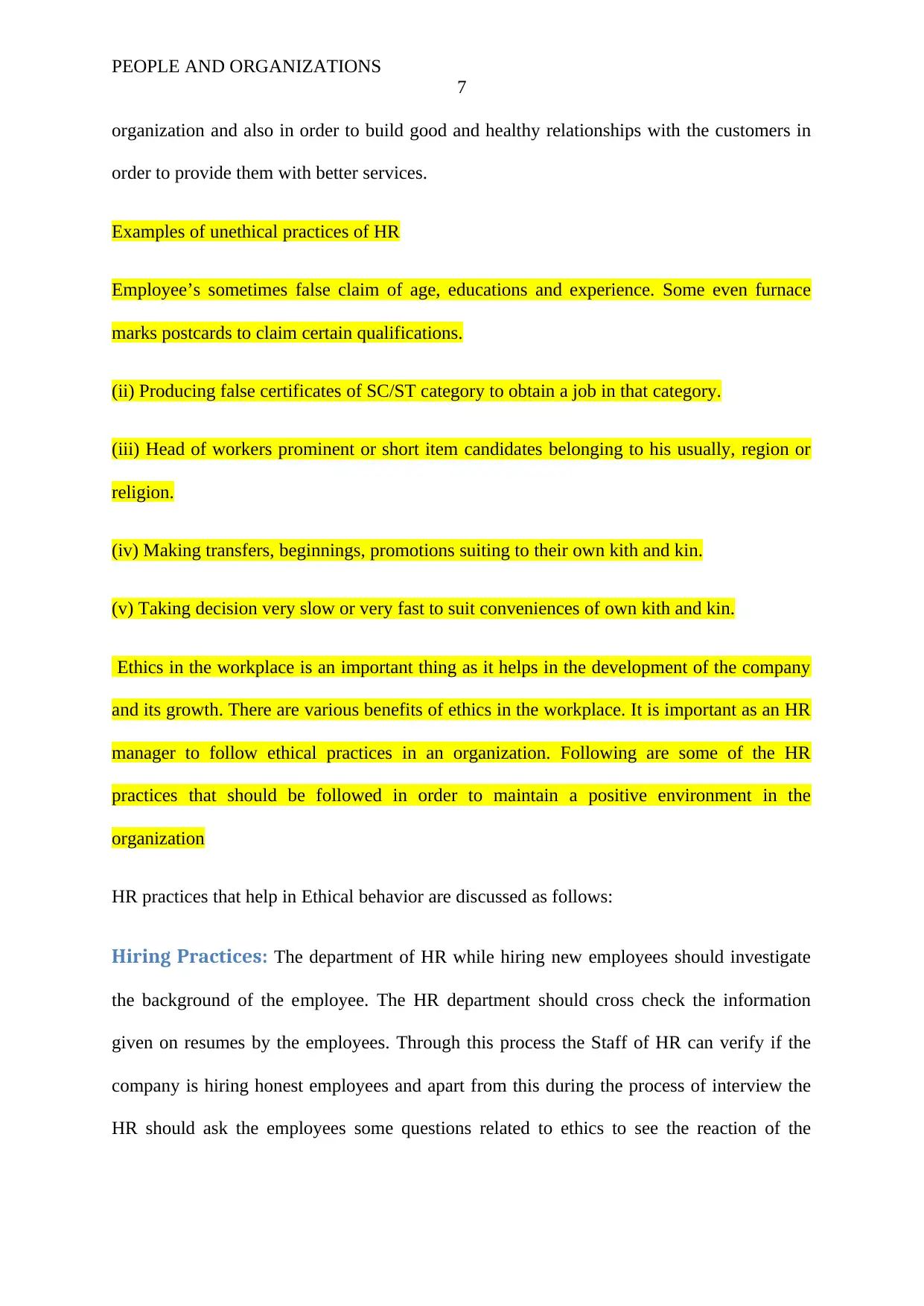
PEOPLE AND ORGANIZATIONS
7
organization and also in order to build good and healthy relationships with the customers in
order to provide them with better services.
Examples of unethical practices of HR
Employee’s sometimes false claim of age, educations and experience. Some even furnace
marks postcards to claim certain qualifications.
(ii) Producing false certificates of SC/ST category to obtain a job in that category.
(iii) Head of workers prominent or short item candidates belonging to his usually, region or
religion.
(iv) Making transfers, beginnings, promotions suiting to their own kith and kin.
(v) Taking decision very slow or very fast to suit conveniences of own kith and kin.
Ethics in the workplace is an important thing as it helps in the development of the company
and its growth. There are various benefits of ethics in the workplace. It is important as an HR
manager to follow ethical practices in an organization. Following are some of the HR
practices that should be followed in order to maintain a positive environment in the
organization
HR practices that help in Ethical behavior are discussed as follows:
Hiring Practices: The department of HR while hiring new employees should investigate
the background of the employee. The HR department should cross check the information
given on resumes by the employees. Through this process the Staff of HR can verify if the
company is hiring honest employees and apart from this during the process of interview the
HR should ask the employees some questions related to ethics to see the reaction of the
7
organization and also in order to build good and healthy relationships with the customers in
order to provide them with better services.
Examples of unethical practices of HR
Employee’s sometimes false claim of age, educations and experience. Some even furnace
marks postcards to claim certain qualifications.
(ii) Producing false certificates of SC/ST category to obtain a job in that category.
(iii) Head of workers prominent or short item candidates belonging to his usually, region or
religion.
(iv) Making transfers, beginnings, promotions suiting to their own kith and kin.
(v) Taking decision very slow or very fast to suit conveniences of own kith and kin.
Ethics in the workplace is an important thing as it helps in the development of the company
and its growth. There are various benefits of ethics in the workplace. It is important as an HR
manager to follow ethical practices in an organization. Following are some of the HR
practices that should be followed in order to maintain a positive environment in the
organization
HR practices that help in Ethical behavior are discussed as follows:
Hiring Practices: The department of HR while hiring new employees should investigate
the background of the employee. The HR department should cross check the information
given on resumes by the employees. Through this process the Staff of HR can verify if the
company is hiring honest employees and apart from this during the process of interview the
HR should ask the employees some questions related to ethics to see the reaction of the
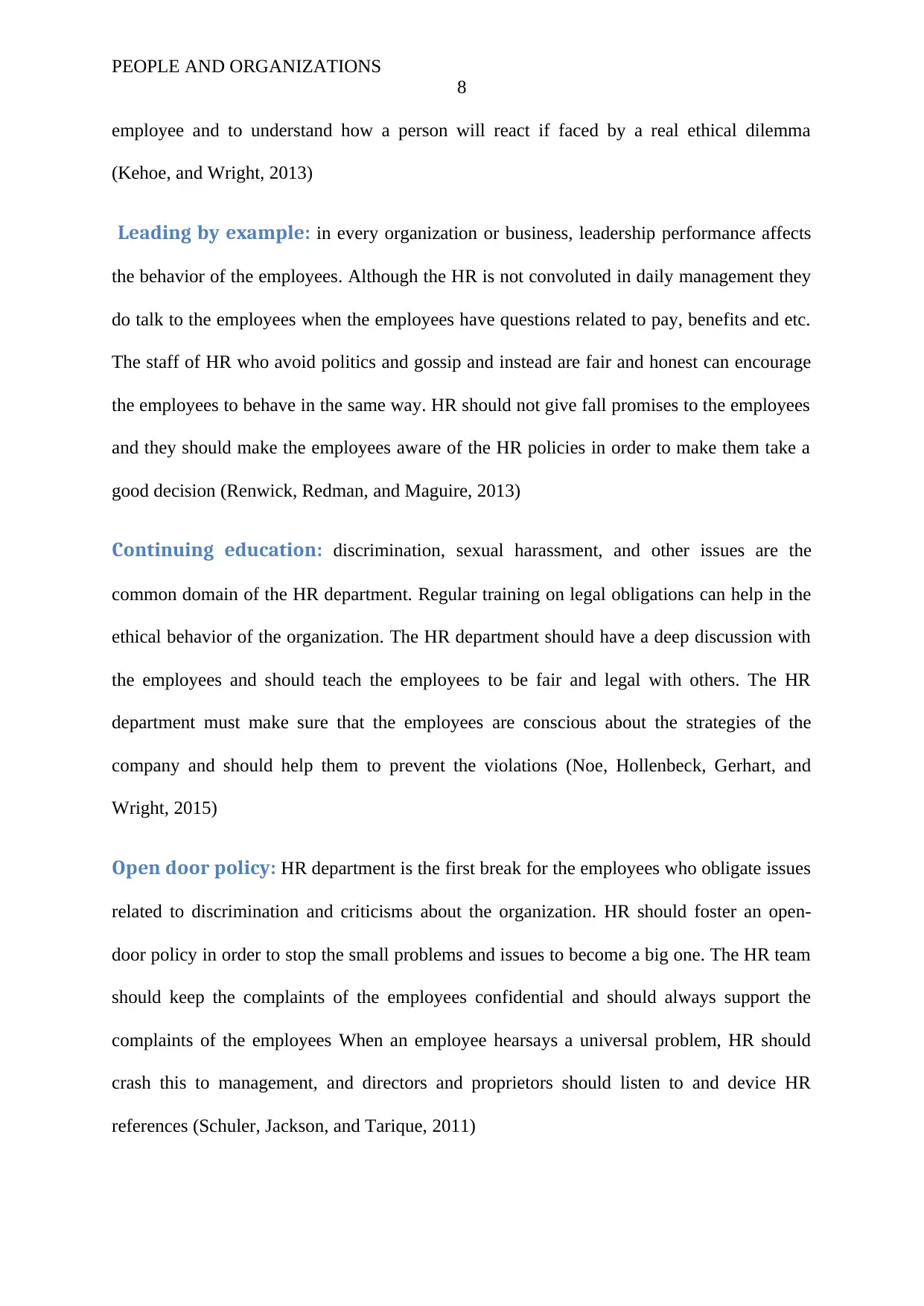
PEOPLE AND ORGANIZATIONS
8
employee and to understand how a person will react if faced by a real ethical dilemma
(Kehoe, and Wright, 2013)
Leading by example: in every organization or business, leadership performance affects
the behavior of the employees. Although the HR is not convoluted in daily management they
do talk to the employees when the employees have questions related to pay, benefits and etc.
The staff of HR who avoid politics and gossip and instead are fair and honest can encourage
the employees to behave in the same way. HR should not give fall promises to the employees
and they should make the employees aware of the HR policies in order to make them take a
good decision (Renwick, Redman, and Maguire, 2013)
Continuing education: discrimination, sexual harassment, and other issues are the
common domain of the HR department. Regular training on legal obligations can help in the
ethical behavior of the organization. The HR department should have a deep discussion with
the employees and should teach the employees to be fair and legal with others. The HR
department must make sure that the employees are conscious about the strategies of the
company and should help them to prevent the violations (Noe, Hollenbeck, Gerhart, and
Wright, 2015)
Open door policy: HR department is the first break for the employees who obligate issues
related to discrimination and criticisms about the organization. HR should foster an open-
door policy in order to stop the small problems and issues to become a big one. The HR team
should keep the complaints of the employees confidential and should always support the
complaints of the employees When an employee hearsays a universal problem, HR should
crash this to management, and directors and proprietors should listen to and device HR
references (Schuler, Jackson, and Tarique, 2011)
8
employee and to understand how a person will react if faced by a real ethical dilemma
(Kehoe, and Wright, 2013)
Leading by example: in every organization or business, leadership performance affects
the behavior of the employees. Although the HR is not convoluted in daily management they
do talk to the employees when the employees have questions related to pay, benefits and etc.
The staff of HR who avoid politics and gossip and instead are fair and honest can encourage
the employees to behave in the same way. HR should not give fall promises to the employees
and they should make the employees aware of the HR policies in order to make them take a
good decision (Renwick, Redman, and Maguire, 2013)
Continuing education: discrimination, sexual harassment, and other issues are the
common domain of the HR department. Regular training on legal obligations can help in the
ethical behavior of the organization. The HR department should have a deep discussion with
the employees and should teach the employees to be fair and legal with others. The HR
department must make sure that the employees are conscious about the strategies of the
company and should help them to prevent the violations (Noe, Hollenbeck, Gerhart, and
Wright, 2015)
Open door policy: HR department is the first break for the employees who obligate issues
related to discrimination and criticisms about the organization. HR should foster an open-
door policy in order to stop the small problems and issues to become a big one. The HR team
should keep the complaints of the employees confidential and should always support the
complaints of the employees When an employee hearsays a universal problem, HR should
crash this to management, and directors and proprietors should listen to and device HR
references (Schuler, Jackson, and Tarique, 2011)
⊘ This is a preview!⊘
Do you want full access?
Subscribe today to unlock all pages.

Trusted by 1+ million students worldwide
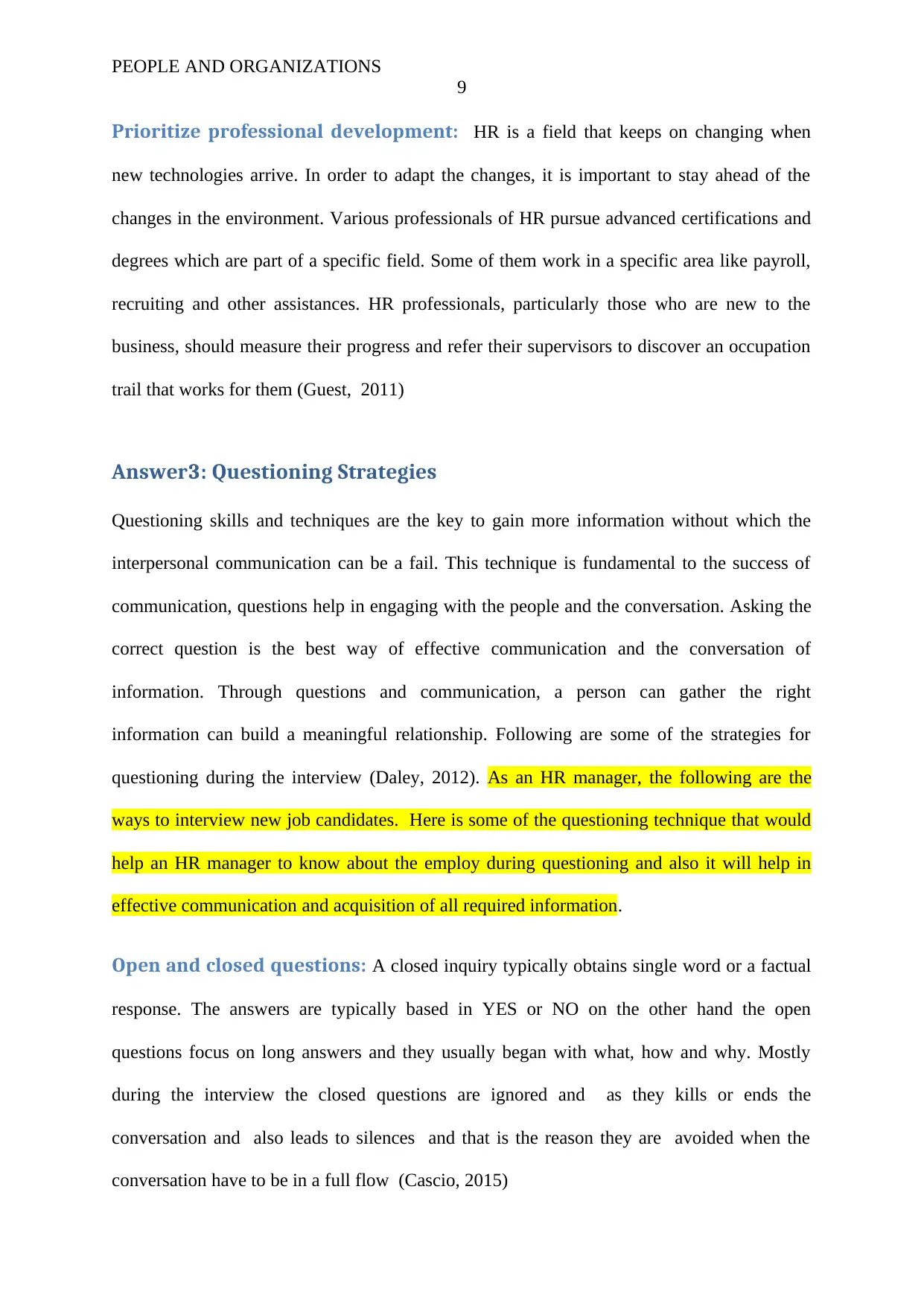
PEOPLE AND ORGANIZATIONS
9
Prioritize professional development: HR is a field that keeps on changing when
new technologies arrive. In order to adapt the changes, it is important to stay ahead of the
changes in the environment. Various professionals of HR pursue advanced certifications and
degrees which are part of a specific field. Some of them work in a specific area like payroll,
recruiting and other assistances. HR professionals, particularly those who are new to the
business, should measure their progress and refer their supervisors to discover an occupation
trail that works for them (Guest, 2011)
Answer3: Questioning Strategies
Questioning skills and techniques are the key to gain more information without which the
interpersonal communication can be a fail. This technique is fundamental to the success of
communication, questions help in engaging with the people and the conversation. Asking the
correct question is the best way of effective communication and the conversation of
information. Through questions and communication, a person can gather the right
information can build a meaningful relationship. Following are some of the strategies for
questioning during the interview (Daley, 2012). As an HR manager, the following are the
ways to interview new job candidates. Here is some of the questioning technique that would
help an HR manager to know about the employ during questioning and also it will help in
effective communication and acquisition of all required information.
Open and closed questions: A closed inquiry typically obtains single word or a factual
response. The answers are typically based in YES or NO on the other hand the open
questions focus on long answers and they usually began with what, how and why. Mostly
during the interview the closed questions are ignored and as they kills or ends the
conversation and also leads to silences and that is the reason they are avoided when the
conversation have to be in a full flow (Cascio, 2015)
9
Prioritize professional development: HR is a field that keeps on changing when
new technologies arrive. In order to adapt the changes, it is important to stay ahead of the
changes in the environment. Various professionals of HR pursue advanced certifications and
degrees which are part of a specific field. Some of them work in a specific area like payroll,
recruiting and other assistances. HR professionals, particularly those who are new to the
business, should measure their progress and refer their supervisors to discover an occupation
trail that works for them (Guest, 2011)
Answer3: Questioning Strategies
Questioning skills and techniques are the key to gain more information without which the
interpersonal communication can be a fail. This technique is fundamental to the success of
communication, questions help in engaging with the people and the conversation. Asking the
correct question is the best way of effective communication and the conversation of
information. Through questions and communication, a person can gather the right
information can build a meaningful relationship. Following are some of the strategies for
questioning during the interview (Daley, 2012). As an HR manager, the following are the
ways to interview new job candidates. Here is some of the questioning technique that would
help an HR manager to know about the employ during questioning and also it will help in
effective communication and acquisition of all required information.
Open and closed questions: A closed inquiry typically obtains single word or a factual
response. The answers are typically based in YES or NO on the other hand the open
questions focus on long answers and they usually began with what, how and why. Mostly
during the interview the closed questions are ignored and as they kills or ends the
conversation and also leads to silences and that is the reason they are avoided when the
conversation have to be in a full flow (Cascio, 2015)
Paraphrase This Document
Need a fresh take? Get an instant paraphrase of this document with our AI Paraphraser
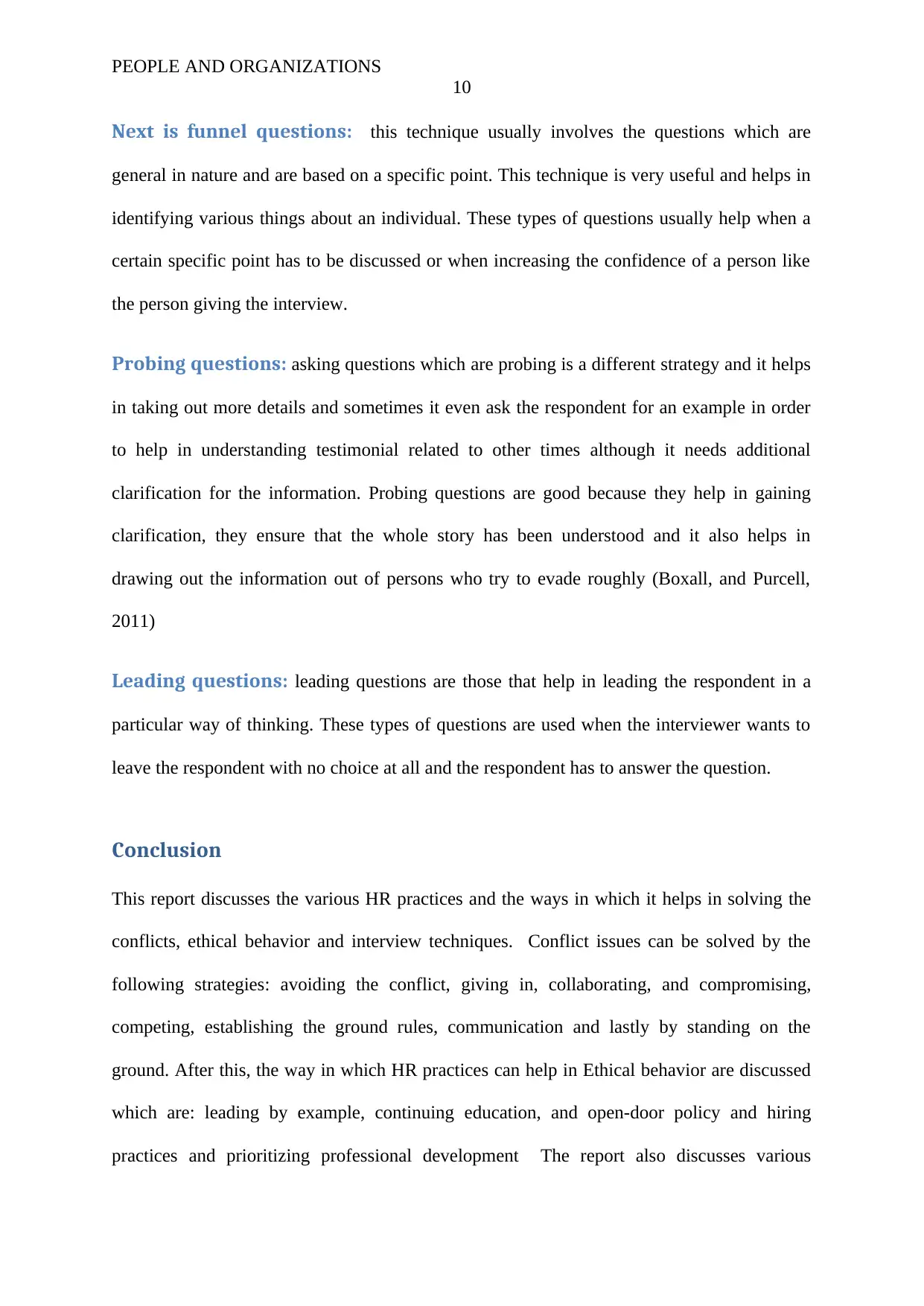
PEOPLE AND ORGANIZATIONS
10
Next is funnel questions: this technique usually involves the questions which are
general in nature and are based on a specific point. This technique is very useful and helps in
identifying various things about an individual. These types of questions usually help when a
certain specific point has to be discussed or when increasing the confidence of a person like
the person giving the interview.
Probing questions: asking questions which are probing is a different strategy and it helps
in taking out more details and sometimes it even ask the respondent for an example in order
to help in understanding testimonial related to other times although it needs additional
clarification for the information. Probing questions are good because they help in gaining
clarification, they ensure that the whole story has been understood and it also helps in
drawing out the information out of persons who try to evade roughly (Boxall, and Purcell,
2011)
Leading questions: leading questions are those that help in leading the respondent in a
particular way of thinking. These types of questions are used when the interviewer wants to
leave the respondent with no choice at all and the respondent has to answer the question.
Conclusion
This report discusses the various HR practices and the ways in which it helps in solving the
conflicts, ethical behavior and interview techniques. Conflict issues can be solved by the
following strategies: avoiding the conflict, giving in, collaborating, and compromising,
competing, establishing the ground rules, communication and lastly by standing on the
ground. After this, the way in which HR practices can help in Ethical behavior are discussed
which are: leading by example, continuing education, and open-door policy and hiring
practices and prioritizing professional development The report also discusses various
10
Next is funnel questions: this technique usually involves the questions which are
general in nature and are based on a specific point. This technique is very useful and helps in
identifying various things about an individual. These types of questions usually help when a
certain specific point has to be discussed or when increasing the confidence of a person like
the person giving the interview.
Probing questions: asking questions which are probing is a different strategy and it helps
in taking out more details and sometimes it even ask the respondent for an example in order
to help in understanding testimonial related to other times although it needs additional
clarification for the information. Probing questions are good because they help in gaining
clarification, they ensure that the whole story has been understood and it also helps in
drawing out the information out of persons who try to evade roughly (Boxall, and Purcell,
2011)
Leading questions: leading questions are those that help in leading the respondent in a
particular way of thinking. These types of questions are used when the interviewer wants to
leave the respondent with no choice at all and the respondent has to answer the question.
Conclusion
This report discusses the various HR practices and the ways in which it helps in solving the
conflicts, ethical behavior and interview techniques. Conflict issues can be solved by the
following strategies: avoiding the conflict, giving in, collaborating, and compromising,
competing, establishing the ground rules, communication and lastly by standing on the
ground. After this, the way in which HR practices can help in Ethical behavior are discussed
which are: leading by example, continuing education, and open-door policy and hiring
practices and prioritizing professional development The report also discusses various
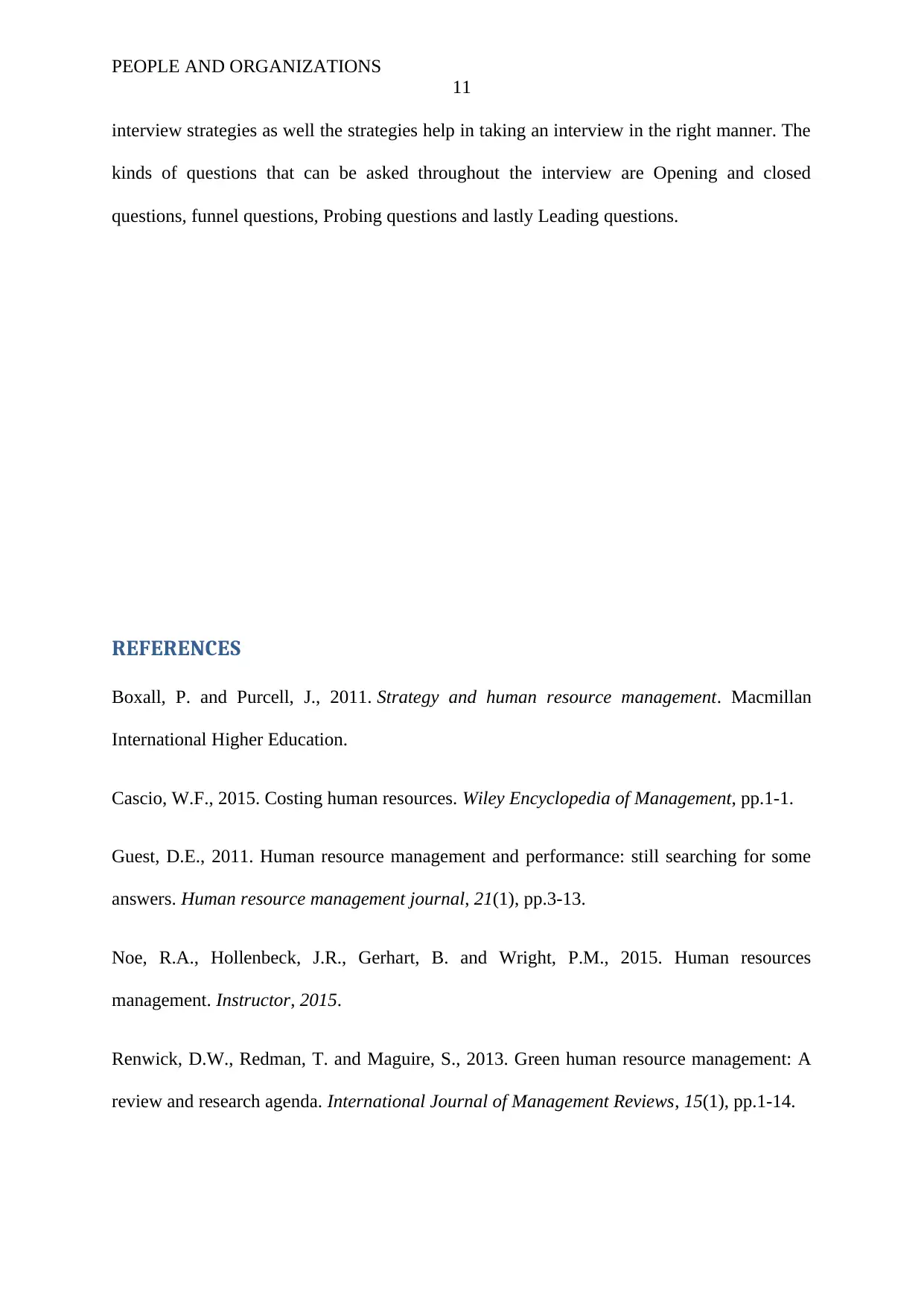
PEOPLE AND ORGANIZATIONS
11
interview strategies as well the strategies help in taking an interview in the right manner. The
kinds of questions that can be asked throughout the interview are Opening and closed
questions, funnel questions, Probing questions and lastly Leading questions.
REFERENCES
Boxall, P. and Purcell, J., 2011. Strategy and human resource management. Macmillan
International Higher Education.
Cascio, W.F., 2015. Costing human resources. Wiley Encyclopedia of Management, pp.1-1.
Guest, D.E., 2011. Human resource management and performance: still searching for some
answers. Human resource management journal, 21(1), pp.3-13.
Noe, R.A., Hollenbeck, J.R., Gerhart, B. and Wright, P.M., 2015. Human resources
management. Instructor, 2015.
Renwick, D.W., Redman, T. and Maguire, S., 2013. Green human resource management: A
review and research agenda. International Journal of Management Reviews, 15(1), pp.1-14.
11
interview strategies as well the strategies help in taking an interview in the right manner. The
kinds of questions that can be asked throughout the interview are Opening and closed
questions, funnel questions, Probing questions and lastly Leading questions.
REFERENCES
Boxall, P. and Purcell, J., 2011. Strategy and human resource management. Macmillan
International Higher Education.
Cascio, W.F., 2015. Costing human resources. Wiley Encyclopedia of Management, pp.1-1.
Guest, D.E., 2011. Human resource management and performance: still searching for some
answers. Human resource management journal, 21(1), pp.3-13.
Noe, R.A., Hollenbeck, J.R., Gerhart, B. and Wright, P.M., 2015. Human resources
management. Instructor, 2015.
Renwick, D.W., Redman, T. and Maguire, S., 2013. Green human resource management: A
review and research agenda. International Journal of Management Reviews, 15(1), pp.1-14.
⊘ This is a preview!⊘
Do you want full access?
Subscribe today to unlock all pages.

Trusted by 1+ million students worldwide
1 out of 13
Related Documents
Your All-in-One AI-Powered Toolkit for Academic Success.
+13062052269
info@desklib.com
Available 24*7 on WhatsApp / Email
![[object Object]](/_next/static/media/star-bottom.7253800d.svg)
Unlock your academic potential
Copyright © 2020–2025 A2Z Services. All Rights Reserved. Developed and managed by ZUCOL.




